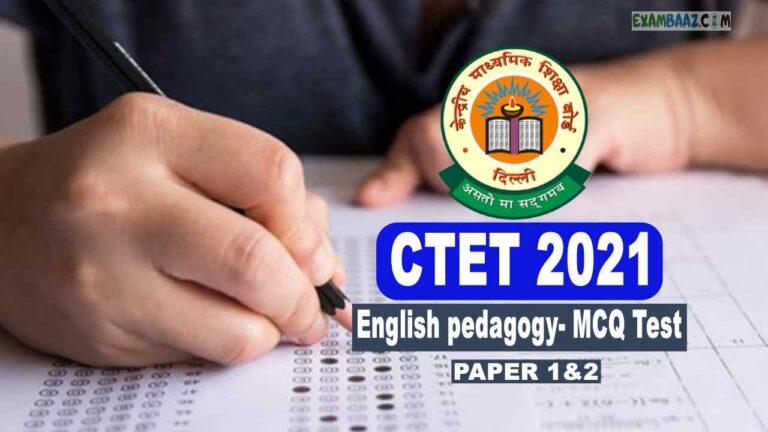CTET 2021 (English pedagogy Practice set for CTET): केंद्रीय माध्यमिक शिक्षा बोर्ड (CBSE) द्वारा पहली बार सीटेट परीक्षा ऑनलाइन आयोजित की जा रही है, यह परीक्षा 16 दिसंबर से 13 जनवरी 2022 तक कंप्यूटर आधारित CBT मोड में ली जाएगी, जिसके एडमिट कार्ड दिसंबर के पहले सप्ताह में जारी किए जाएंगे। इस बार शिक्षक बनने की चाह रखने वाले लाखों अभ्यार्थी सीटेट परीक्षा में सम्मिलित होंगे। चूकी परीक्षा शुरू होने में अब कुछ दिन का समय ही शेष रह गया है ऐसे में अभ्यर्थी को रिवीजन के साथ ही मॉडल क्वेश्चन पेपर/ मॉक टेस्ट का अभ्यास करना बेहद आवश्यक है।
आपको बता दें कि: CBSE द्वारा सीटेट परीक्षा वर्ष में दो बार आयोजित की जाती है सीटेट परीक्षा पास करने वाले अभ्यर्थी केंद्र सरकार के अधीन स्कूलों तथा संस्थाओं में शिक्षक पद पर आवेदन के पात्र हो जाते हैं इसके अलावा कई राज्य सरकारें भी सीटेट को राज्य में मान्यता देती हैं साथ ही बड़े निजी स्कूलों शिक्षक की जॉब में सीटेट पास उम्मीदवार को वरीयता दी जाती है
परीक्षा में आप कुछ ही दिन का समय शेष रह गया है ऐसे में परीक्षा में शामिल होने वाले उम्मीदवारों को अपना रिवीजन शुरू कर देना चाहिए। हम रोजाना CTET परीक्षा के विभिन्न टॉपिक्स पर मॉक टेस्ट/ रिवीजन क्वेश्चन शेयर कर रहे हैं और इसी श्रंखला में आज हम CTET पेपर 1 तथा पेपर 2 हेतु इंग्लिश पेडगॉजी के कुछ महत्वपूर्ण संभावित प्रश्न शेयर कर रहे हैं। परीक्षा से पूर्व इन प्रश्नों पर एक नजर अवश्य डालें ।
इन सवालों का जवाब देकर अपनी तैयारी का लेबल चेक करें- English Pedagogy Practice Set for CTET Paper 1 & 2
1.The multilingual nature of the Indian classroom must be used as a resource so that____
a) Children can learn many languages
b) The teacher develops language proficiency
c) Every child feel secure and accepted
d) Every child learns at the same pace
Ans- (c)
2. While checking the notebooks the teacher observe that a child has repeatedly made some errors in writing such as reverse image as b-d, m-w. Child is showing the signs of____.
a) Learning disability
b) Learning Differences
c) Learning preference
d) Learning style
Ans- (a)
3. Active vocabulary consists of words which are___.
a) Used frequently
b) Phonological and lexical
c) Used occasionally
d) Difficult to pronounce
Ans- (a)
4. Morpheme is the:
a) Unit of a word that can be broken up into new meaning
b) Smallest unit of a phrase
c) Smallest unit of a word.
d) Smallest unit of meaning that cannot be broken up.
Ans- (d)
5. A teacher of class || user uses learner’s knowledge and language to build a bridge between his mother tongue and English language teaching here learner’s language is used in teaching English as a____
a) Resource
b) Pattern
c) Hindrance
d) Translation
Ans- (a)
6.BICS stand for____.
a) Basic inter related communication strategies
b) Basic interpersonal communication skills
c) Bilingual integrated content and syllabus
d) Bilingual interdependent course and syllabus
Ans- (b)
7. Literature for children is considered as a / an reading.
a) Hindrance material for
b) Inspirational source of
c) Additional burden on
d) Authentic source of
Ans- (d)
8. A teacher gives a task of dialogue completion for class 5th students the role of this task in language learning will be _____.
a) To facilitate conversation by giving specific language practice using formulaic expressions.
b) To provide frequent feedback only on grammatical errors
c) Teaching of structures
d) The separation of spoken and written forms of language
Ans- (a)
9. Which one of the following is not a form of literature for children?
a) Myths and legends
b) Tales of heroes of history
c) Picture books
d) Thesaurus
Ans- (d)
10. Which one of the following statements is not correct about print rich environment?
a) Pictures and posters give children and opportunity to talk about things, persons and happenings
b) Encourage children to create their own poems, posters, stories etc. and display them in the class
c) It consists of context based relevant material for children such as pictures, rhymes, stories etc.
d) Once the material is pasted on walls it should not be removed from the whole session
Ans- D
11. Language acquisition stands for:
a) Learning a language without making any deliberate aur conscious effort
b) Learning a language through some specific language methodology
c) Acquiring a language by taking recourse to one’s mother tongue
d) Learning a language with a deliberate and conscious effort
Ans- (a)
12. When language development is a deliberate and conscious effort language is:
a) Brushed up
b) learned
c) Acquired
d) Honed
Ans- (b)
13. Home language is____ in a natural way.
a) Promoted
b) Acquired
c) Learnt
d) Taught
Ans- (b)
14. Which of the following is not true about the status of the English language across the world?
a) English as a heritage language
b) English as a native language
c) English as a foreign language
d) English as a second language
Ans- (a)
15. English belongs to:
a) Indo European family of a language
b). European Celtic family of a languages
c) Nordic family of languages
d) Indo Aryan family of languages
Ans- A
Also Read| Model set Paper: English Pedagogy Practice Questions
यहा हमने English pedagogy के कुछ महत्वपूर्ण सवालो का अध्ययन किया है। CTET सहित सभी TET परीक्षाओ की ऐसी ही अन्य महत्वपूर्ण जानकारी प्राप्त करने के लिए आप हमारे Social Media Handle को जरूर फॉलो करें। आप CTET परीक्षा से संबन्धित किसी भी जानकारी के लिए नीचे कमेंट करके अपने प्रश्न पूछ सकते है।
| Follow Facebook – Click Here |
| Join us on Telegram – Click Here |
| Follow us on Twitter – Click Here |
